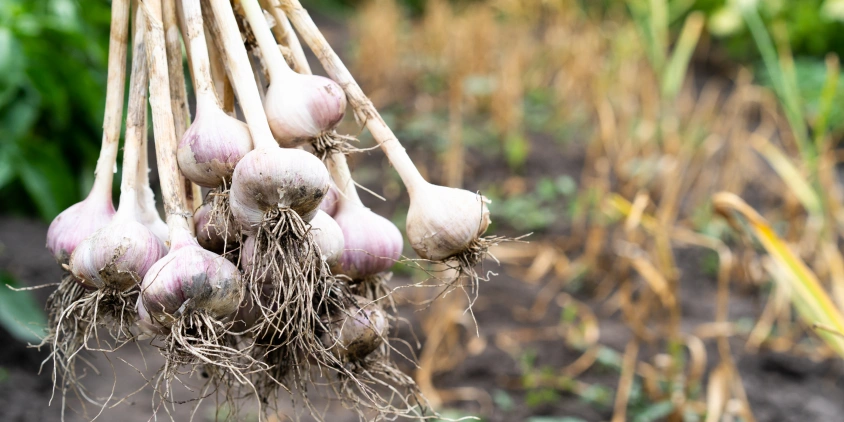
Growing Garlic: From Types And Planting To Harvest
Growing garlic appeals to farmers all over the world because of the effort-to-reward ratio. This crop has steady market demand while also being fairly hardy and hassle-free. Nutrient-rich and well-drained soil is nearly everything the crop craves.
There is no one best way to grow garlic; a lot depends on the variety you choose and local conditions. However, there are some general requirements and tips that might help you streamline the cultivation process. By growing and storing garlic according to these guidelines, crop producers can ensure a consistent stream of income throughout the year.
What Are The Types Of Garlic Plants?
Any garlic variety you grow can be classified into one of two types:
- Hardneck. It has a rigid stalk (scape) at its center. This type grows in cold climates and needs to overwinter to form the bulbs. Large-scale commercial growers often avoid hardneck cultivars due to their small cloves, unsuitable for machine planting, and short shelf life.
- Softneck, also known as non-bolting. It doesn’t produce scapes and focuses its energy on growing bulbs. Softneck garlic adapts to different growing regions but prefers warmer climates. It is a commercially cultivated type largely due to its excellent storage qualities.
Despite being marketed as garlic, it actually belongs to the leek family.
Favorable Garlic Growing Conditions
Garlic, in terms of growing requirements, is one of the least demanding crops. Not only is it space-efficient, but it is also quite hardy. Growing in fertile and well-drained soil will maximize the crop’s potential.
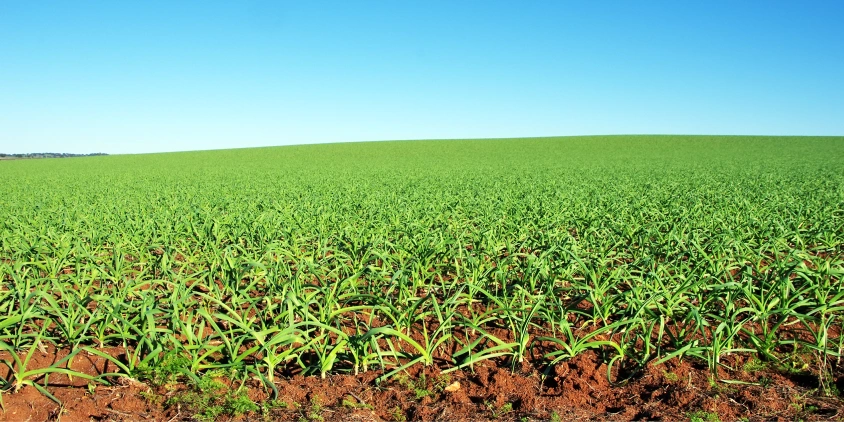
What Climate Does Garlic Grow In?
Due to garlic’s tolerance to low winter temperatures and the need for warm temperatures between 20°C and 38°C in summer, the crop prefers a moderate climate. Even though the crop feels completely fine under temperatures below freezing in the winter, going below -13°F (-25°C) might induce cold stress symptoms such as wilting, drooping, and necrosis.
When the temperature reaches 109°F (43°C), heat stress causes the plant’s growth to slow down and its susceptibility to sunburn to grow. Besides, mold can grow on crops when the relative humidity exceeds 45–50%. To farmers’ relief, in most growing regions, harvesting occurs before the summer heat and humidity peak.
Regardless of growing mostly underground, the plant thrives in full sun (6–8 hours a day).
EOSDA Crop Monitoring offers a good way to evaluate field suitability for garlic farming and stay updated on the weather conditions. You can access weather data (temperature, relative humidity, solar radiation, and more) specific to each of your fields. For effective field selection, examine historical data back to 1979, and for flexible crop management, check out precise 14-day forecasts.
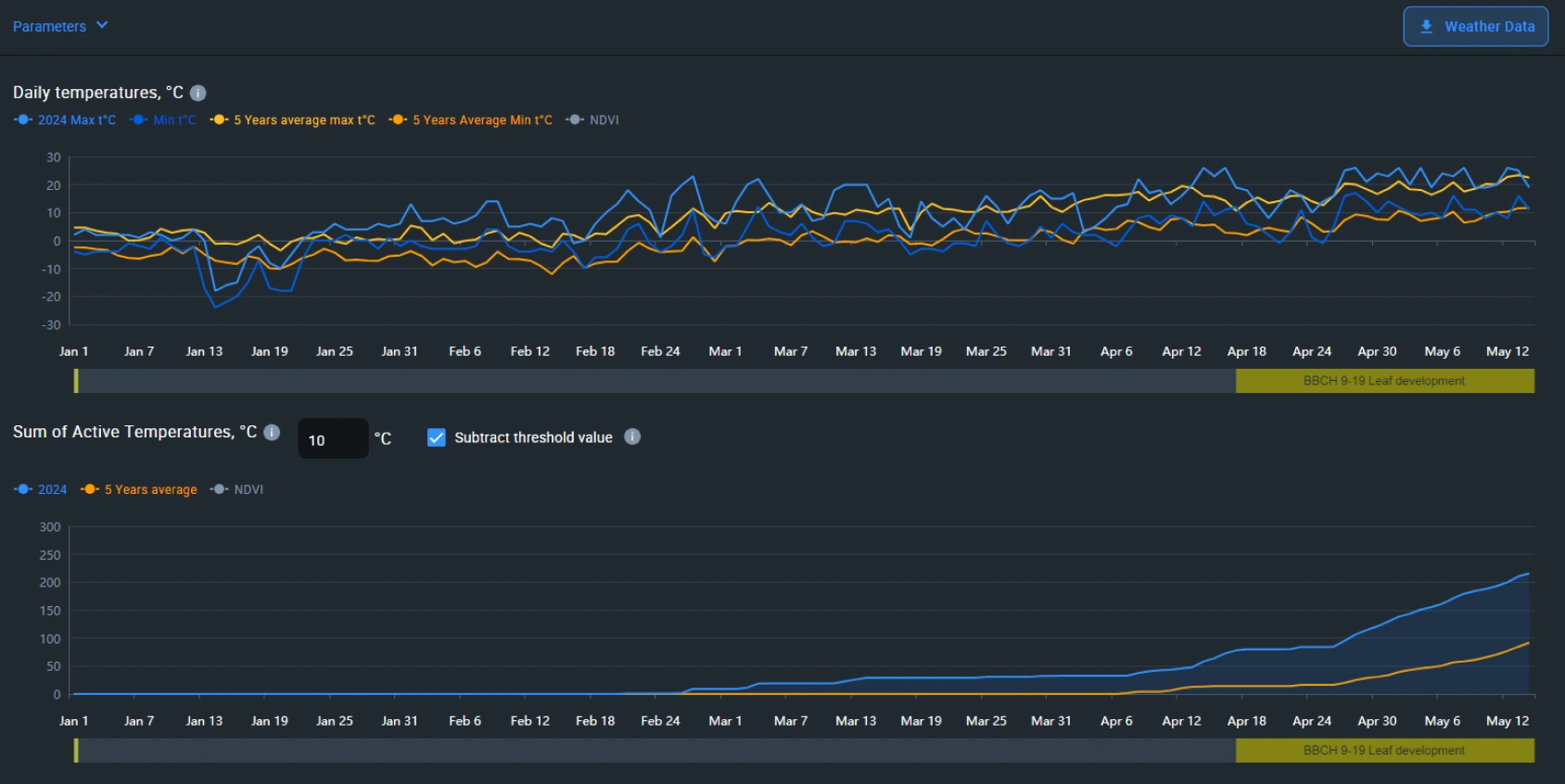

What Is The Best Soil For Garlic?
Garlic grows best in rich, organic-matter-rich, somewhat acidic soils (pH of 6.0–6.5). To adjust the soil pH for growing the crop, you can use ground limestone for highly acidic soils and peat moss for alkaline soils.
Loam, sandy loam, or any other loose, well-drained soil will do well for farming garlic. Plants cultivated in clay or silt soils, which do not drain well, are often affected by fusarium root rot and different bulb diseases. Bulbs might even grow crooked in stony and heavy soils. To make heavy clay more draining and fertile, mix in some sand, gravel, and compost. If the soil is exceptionally compacted and poor, raising beds is a better way of preparing soil for garlic than using amendments.
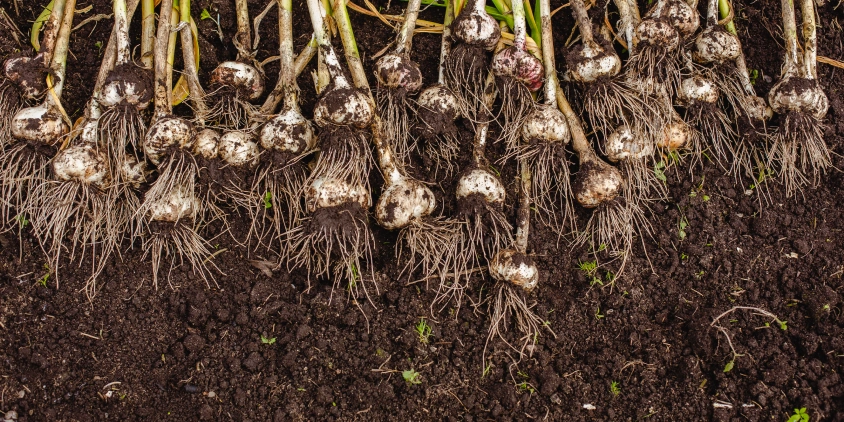
Garlic Planting: When And How
To ensure a decent yield, plant garlic during the appropriate season, which is typically fall. The growing conditions, primarily the climate and soil, determine specific planting guidelines.
When To Plant Garlic
While you can plant softneck varieties early in the spring, planting them in the fall yields larger harvests. And the best time to plant hardneck garlic is between early October and early December. Aim for planting when the soil temperature is 50°F (10°C) .
For the plant to thrive, it needs a four- to eight-week dormancy phase in cooler weather with temperatures of at least 40°F (4°C). Bulbs planted in the fall have enough time to grow strong roots, but not enough to sprout tops before temperatures plummet. Warmer temperatures break the plants’ dormancy in early spring, causing sprouting and bulb formation.
How Deep And Far Apart To Plant Garlic
Plant the cloves 1–2 inches (2.5–5 cm) deep in warm growing zones and 3–4 inches (7.5–10 cm) in colder ones. You can grow larger bulbs by planting deeper in light soils, but avoid doing this in heavy soils. The recommended spacing for planting garlic cloves is 6 inches (15 cm) apart, with 1 foot (30 cm) between rows.
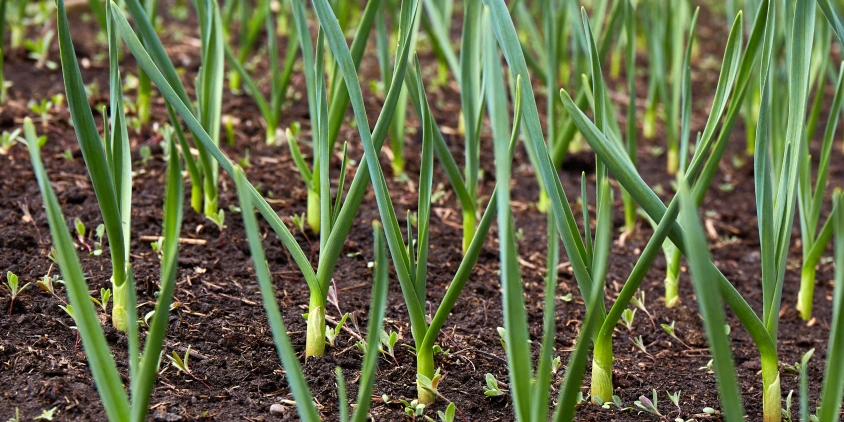
How To Care For Garlic Plants
Because of its high nutritional requirements, the plant benefits from intense fertilization. Sufficient irrigation through drip systems and timely weed management are also essential for growing a healthy crop.
Intense Fertilizing
The crop has a long growing season and, consequently, high nutritional needs, so it’s important to fertilize it thoroughly and make sure the soil pH supports plant nutrient availability. In general, to grow garlic commercially, you’ll need approximately 125 lbm/ac (140 kg/ha) of nitrogen and 150 lbm/ac (168 kg/ha) of both phosphorus and potassium . Before planting, conduct soil testing to ensure the appropriate fertilizer application for your local growing conditions.
You can apply synthetic nitrogen fertilizer or an organic macronutrient source, such as blood meal or chicken manure, through side dressing or broadcasting in the early spring. Apply another round of fertilizer right before the bulbs start to enlarge in response to longer daylight hours, which normally occurs in early May in most growing zones. If the leaves start to wilt, fertilize once again.
Protective Mulching
Spread a thick layer of mulch to the field right after planting or before a predicted frost. Yet, the main reasons to use mulch are to prevent soil moisture loss and cracking rather than to avoid freezing. The crop, with its thin and erect leaves, has a hard time competing with weeds. Therefore, mulching, which helps strangle weeds early in the garlic growing season and facilitates further weed management, is crucial.
Apply 6 inches (15 cm) of loose straw or 4 inches (10 cm) of shredded leaves as an effective, insulating mulch. 2 inches (5 centimeters) of organic mulch is sufficient to prevent weeds from growing and hold moisture in regions where the ground does not freeze.
Stay on top of your mulching and weeding activities using the Field activity log in our crop monitoring software. Schedule and keep records of all the tasks in the intuitive calendar-like interface. With the Field activity log, you can also manage your expenses for garlic plant care, such as herbicide treatments, which ensures efficient resource allocation and cost management.

EOSDA Crop Monitoring
Fields analytics tool with access to high-resolution satellite images for remote problem areas identification!
Proactive Pest And Disease Control
Since this plant is a natural insect repellant, it rarely gets pests and diseases that afflict other vegetables. Maintain healthy growing conditions by rotating crops on at least three-year-long cycles. This prevents pathogens from accumulating in the soil. When planning rotations, keep in mind that grains like wheat and barley can host the same pathogens as garlic.
| Pest/Disease | Symptoms | Control |
|---|---|---|
| Onion maggots |
|
|
| Onion thrips |
|
|
| White rot |
|
|
The Disease risk feature in EOSDA Crop Monitoring provides growers with much-needed early warnings about potential infestations. This allows crop producers to handle the issue proactively and minimize its impact. For insurers, this remote crop monitoring capability saves significant amounts of money when assessing risks and appraising damages on large farmlands.
Sufficient Irrigation
Though the crop doesn’t need too much water, it can suffer from water stress if it does not receive enough precipitation or watering. On the other hand, if watered excessively, bulbs could decay. Strike the balance by keeping the soil uniformly moist during most of the garlic growing season. The best way to achieve this is through drip irrigation. To prevent mold from growing, stop watering 2–3 weeks before harvesting and allow the soil to dry out.
A weekly watering of 0.5–1 inch (13–25 mm) is usually sufficient for the crops, with a small increase during exceptionally hot weather.
How Long Does Garlic Take To Grow?
When the plant grows a small bulb, which usually happens about 1–1.5 months before complete maturation, some farmers partly harvest crops as young, or baby, garlic — a seasonal delicacy. In varieties suited for cultivation in moderate growing zones, the bulb formation process is day-length-dependent and is triggered by 12 hours of sunlight during the day. These day-length-dependent varieties take around 9–10 months to grow and mature. However, there are day-length-neutral short-season varieties that only need around 5.5–6 months to grow.
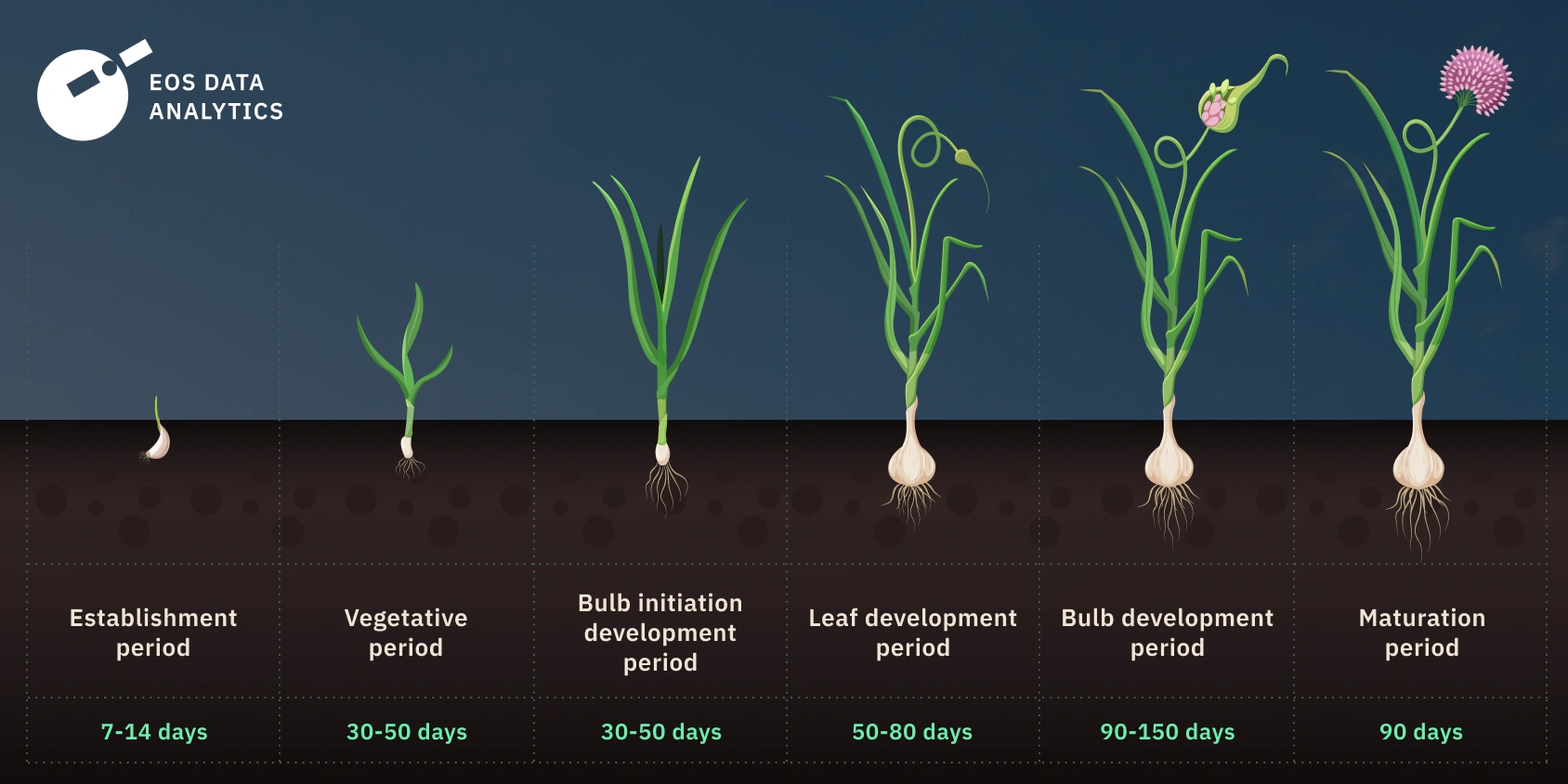
Harvesting And Storing Garlic
The farmer’s main objective is to harvest the largest and finest bulbs possible. The bulbs actively grow in size in the last three to four weeks of the crop’s growth lifecycle, so don’t rush the harvest. After harvesting, cure the bulbs and store them in a cool area.
When And How To Harvest Garlic
The harvest window for garlic varies from growing region to growing region, but it typically spans June through August. The cultivar’s “days to maturity” will give you a good idea of when you should expect to harvest your crop. Consider, however, that day length and temperature, rather than days in the ground, will determine when garlic is ready to harvest. Temperature effects could easily delay or accelerate harvesting by a few days.
A common indicator is when the leaves begin to yellow but are not yet dry, although not all varieties follow this rule. When checking if the crop is mature, the NDRE index — one of the multiple in-built indices in EOSDA Crop Monitoring — is invaluable. Midway through the growing season, crop producers should switch from using the NDVI to the NDRE for more accurate findings.
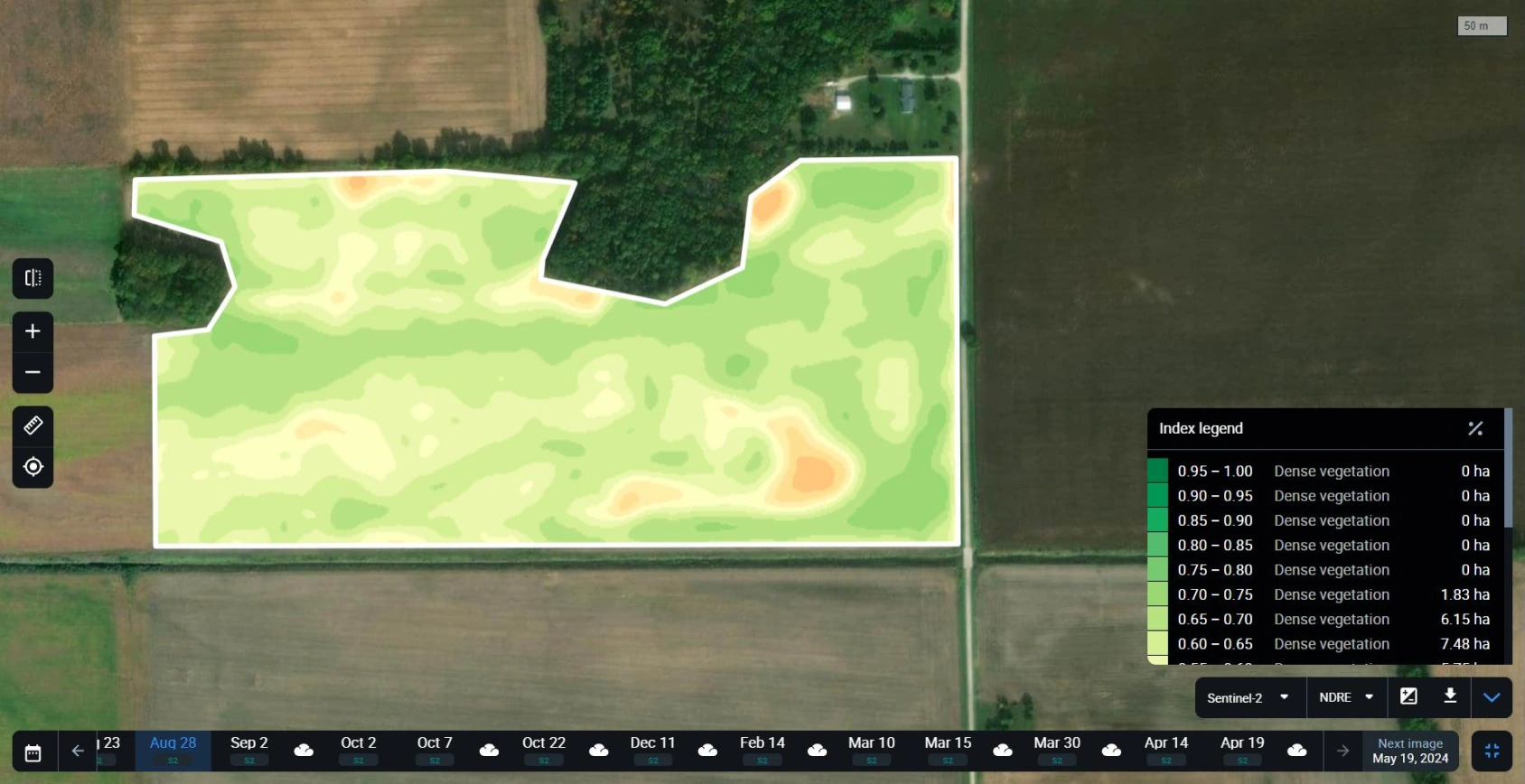
Bulk garlic harvesting typically involves using a mechanized harvester. During the harvesting process, a specialized shaker plate shakes the bulbs to remove the soil, followed by the trimming of the stem.

How To Cure And Store Garlic After Harvesting
Curing the bulbs can extend their storage life and keep them free of mold and other infections. There are two steps to curing the bulbs:
- in the ground, when the crop’s leaves start to wither;
- after garlic is harvested and placed in a well-ventilated, dark, and dry facility for around 2 weeks.
Once the bulbs’ roots and wrappings have dried, you can take the last steps to prepare the harvested crops for storage. Do not wash the bulbs; instead, brush away grime and discard the dirtiest wrappers. Next, cut roots to about 0.25 inches (0.6 cm) and tops to 1–2 inches (2.5–5 cm).
Store the bulbs in a cool, well-ventilated facility (good ventilation is crucial in environments with over 50% humidity). A temperature range of 55–57°F (13–14°C) is perfect, but anything over 50°F (10°C) will prevent sprouting, and anything below 68°F (20°C) will keep the bulbs from drying up. Softneck garlic, when properly stored, can endure and generate income until the end of the next growing season.
About the author:
Vasyl Cherlinka is a Doctor of Biosciences specializing in pedology (soil science), with 30 years of experience in the field. He attended the engineering college in Ukraine and received his degree in agrochemistry, agronomy and soil science in the Chernivtsi National University. Since 2018, Dr. Cherlinka has been advising EOSDA on problems in soil science, agronomy, and agrochemistry.
Recent articles

Analyze 2025 & Plan Your Best Year Yet: LandViewer Christmas Offer
It’s the most wonderful time of the year! The Christmas holidays are here, and so is your chance to analyze 2025 and plan a prosperous 2026 with more affordable Pro plans in LandViewer.

EOSDA Models Climate Change Impact On Sugarcane Yields
EOSDA modeled future temperature, rainfall, and other climate impacts on Veracruz sugarcane. The results help growers plan long-term adaptation strategies, including timing, varieties, and irrigation.

EOSDA LandViewer Black Friday Sale: Exclusive Offers & Giveaway
This Black Friday, LandViewer offers new users the chance to save on monthly plans, get extra months with yearly subscriptions, and participate in a free annual plan giveaway.